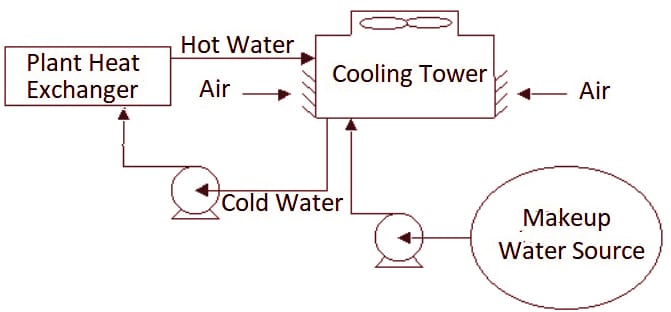The function of cooling tower (CT) is to reduce the hotness of a water stream through expelling high temperature from water and transmitting it to the air.
The principle behind the cooling tower is simply evaporation. As the water falls down the column, due to temperature difference between water and air, the water droplets lose the heat as latent heat of vaporization, thus decreasing the temperature of the water.

The make-up water source is used to replenish water lost to evaporation. Hot water from heat exchangers is sent to the CT and the water exits the CT is sent back to the exchangers or to other units for further cooling.
Types Of Cooling Tower
-
Natural Draft Cooling Tower
Natural draft towers use very large concrete chimneys to introduce air through the media. Due to the large size of these towers, they are generally used for water flow rates above 45,000 m3 /hr. These types of towers are used only by utility power stations.
-
Mechanical or Induced Draft Cooling Tower
Induced draft cooling tower utilize large fans to force or suck air through circulated water. The water falls downward over fill surfaces, which help increase the contact time between the water and the air – this helps maximize heat transfer between the two. Cooling rates of mechanical draft or induced draft CT depend upon their fan diameter and speed of operation.
Components of Cooling Tower
The basic components of an evaporative cooling tower are:
-
Frame and Casing
These are the structural frames that support the exterior enclosures, motors, fans etc.
-
Fill
They are used to facilitate heat transfer by maximizing water and air contact.
-
Cold Water Basin
They are located at or near bottom of the cooling tower, receives the cooled water that flows through the tower and fill.
-
Drift Eliminator
They are used to capture water droplets entrapped in the air stream that otherwise would be lost to the atmosphere.
-
Air Inlet
It is the point of entry for the air entering a CT.
-
Louvers
The function of louvers is to equalize air flow into the fill and retain the water within the CT.
-
Nozzle
The function of nozzle is to uniform distribute water at the top of the fill and achieve proper wetting of the entire fill surface.
-
Fans
The function of fan is to deliver the desired air flow.
Cooling Tower Performance
The significant factors of cooling tower are
-
Range
CT Range (°C) = Cooling water inlet temp in °C – Cooling water outlet temp in °C
-
Approach
CT Approach (°C) = Cooling water outlet temp in in °C – Wet bulb temp in °C
-
Cooling Tower Effectiveness
CT Effectiveness = (Range /(Range +Approach)) x 100
-
Cooling Capacity
Cooling Capacity (Kcal/hr) = mass flow rate of water x specific heat x temperature difference
-
Evaporation Loss
Evaporation Loss (m3/hr) = 0.00085 x 1.8 x circulation rate in m3/hr x (T1-T2)
T1-T2 = temp difference between inlet and outlet water.
-
Cycle of Concentration (COC)
COC = Dissolved solids in circulating water / Dissolved solid in makeup water
-
Blow Down Loses
Blow Down losses = Evaporation loss/(COC-1)
-
Makeup water require
Total losses in circulating water = Evaporation losses + Blow down losses + Drift Losses
Application of Cooling Tower
- Power generation plants
- Heat, ventilation and air conditioning
- Food Industry and other industries sugar factories, petrochemical, oil and gas refineries.
Maintenance of Cooling Towers
The maintenance of CT is very important for the efficient plant operations. Therefore, it is necessary to prevent common problems like scaling, fouling, corrosion, microbiological etc. To overcome these problems following need to be done on regular interval of time:
- Maintain proper air and water flow.
- Ensure there should not be any clogging in pipe lines.
- Main supply line strainer should be cleared on regular basis.
- Chemical dosing should be done to achieve water quality as per requirement and it should be done base on the type of application, location, weather, water quality etc.
- Preventive maintenance of all equipment like fan, motors, belt drive should be done on regular basis.
- Water PH level maintains between 8 to 9.
RELATED SEARCHES